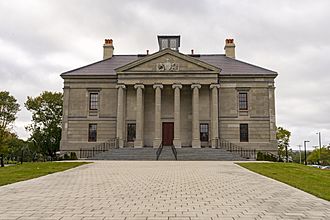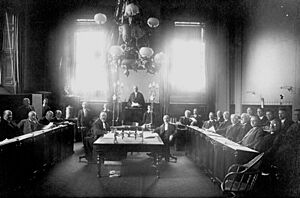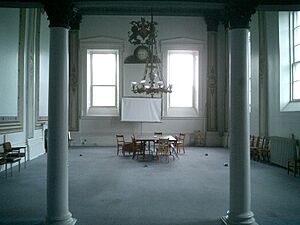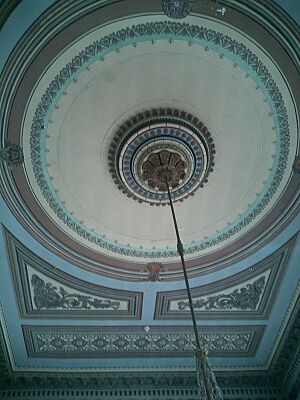Colonial Building facts for kids
Quick facts for kids Colonial Building |
|
|---|---|
 |
|
| General information | |
| Architectural style | Neoclassical |
| Location | Military Road St. John's, Newfoundland and Labrador |
| Country | Canada |
| Coordinates | 47°34′15.34″N 52°42′24.44″W / 47.5709278°N 52.7067889°W |
| Construction started | 24 May 1847 |
| Cost | £18,335 |
| Design and construction | |
| Architect | James Purcell |
| Engineer | Patrick Keough |
The Colonial Building in St. John's was once the main home for the Newfoundland government. It housed the House of Assembly from 1850 to 1959. In 1974, it was recognized as a special Provincial Historic Site.
When Newfoundland first started governing itself in 1832, there wasn't a proper building for its lawmakers. They met in different temporary places. Their very first meeting spot was even a tavern! This was because they forgot to approve money for rent. After many years of moving around, a plan was finally approved in 1846 to build a permanent home for the government.
The first stone of the Colonial Building was laid on May 24, 1847. This was done by Governor Sir John Gaspar Le Marchant. The building officially opened on January 28, 1850.
Contents
Building the Colonial Building
James Purcell was the main architect for the Colonial Building. Patrick Keough was the contractor. The building was designed in a Neoclassical style. It was built using white limestone brought all the way from Little Island, Cork, Ireland.
The front of the building has a large porch with six tall columns. These columns support a triangular top section. This top part is decorated with the Royal Arms. Inside, the main hall has more columns and a special dome ceiling. The two main rooms where laws were made have very high ceilings, about 28 feet tall! The whole building cost £18,335 to build.
In 1880, a painter named Alexander Pindikowski helped decorate the building. He painted beautiful designs inside. He even got his prison sentence reduced by a month for his amazing work!
Here's a fun fact: The political party in charge chose to sit on the left side of the main room. This was unusual, as they usually sat on the right. But they chose the left because that's where the heaters were! It was the warmest spot. Even today, the ruling party in the Newfoundland and Labrador House of Assembly still sits on the left side.
Key Moments in History
The Colonial Building saw many important events happen. In 1855, Newfoundland gained "responsible government" here. This meant its leaders were more directly accountable to the people. It was also the place where Newfoundland joined the Commission of Government in 1934.
From 1946 to 1948, the Newfoundland National Convention met here. This was a big meeting to decide Newfoundland's future. Then, in 1949, Newfoundland officially joined Confederation with Canada at this very building.
The building was also the site of some public protests. On April 5, 1932, a large protest happened. People were upset about how the government was being run. During this protest, windows were broken, doors were smashed, and furniture was destroyed. Repairs cost $10,000. The Prime Minister at the time, Sir Richard Squires, barely escaped the building.
The Colonial Building was also the site of Newfoundland's first bank robbery in 1850. The Newfoundland Savings Bank was in the basement. Robbers stole £413 from it.
On July 28, 1959, the provincial government held its last meeting in the Colonial Building. They then moved to the new Confederation Building.
Restoring the Building
From 2010 to 2015, work was done to fix up the inside of the building. This included making the ceilings in the main rooms strong again. The front of the building and the main entrance area were also restored to look like they did in the 1850s. Because of this work, the building was closed to visitors for a while.
Who Uses the Building Now?
Today, the Colonial Building is home to the Provincial Historic Sites of Newfoundland and Labrador offices. Since 2005, three other groups also use the building. These are non-profit organizations, meaning they don't aim to make money. They include the Museum Association of Newfoundland and Labrador (MANL), the Association of Newfoundland and Labrador Archives (ANLA), and The Newfoundland Historical Society.
Images for kids






